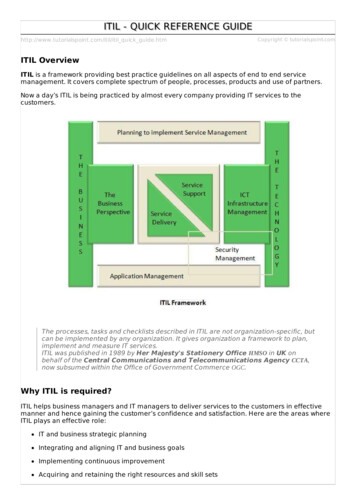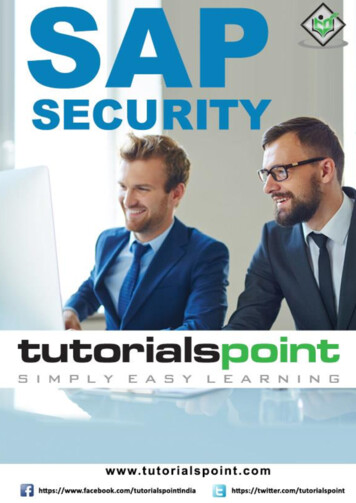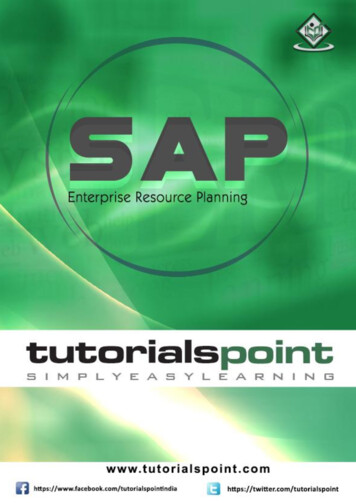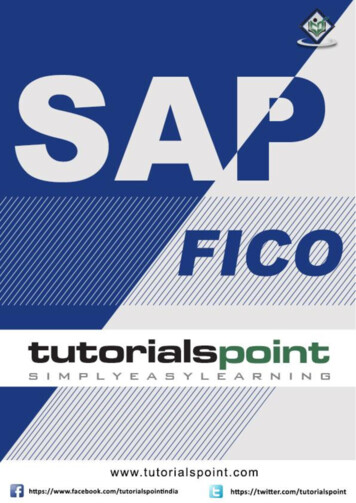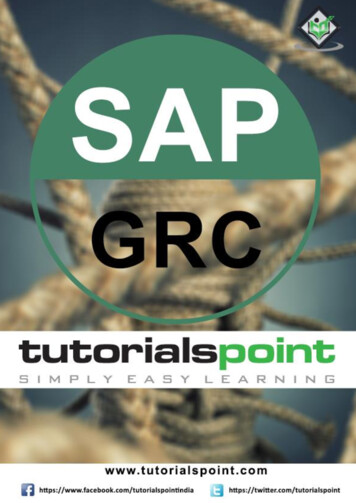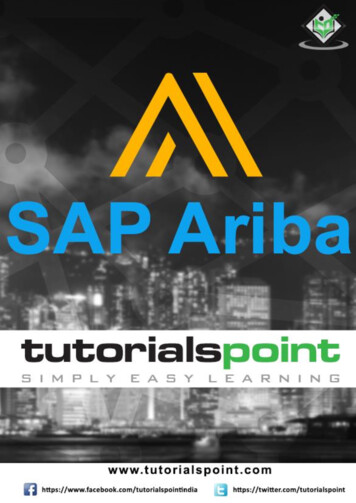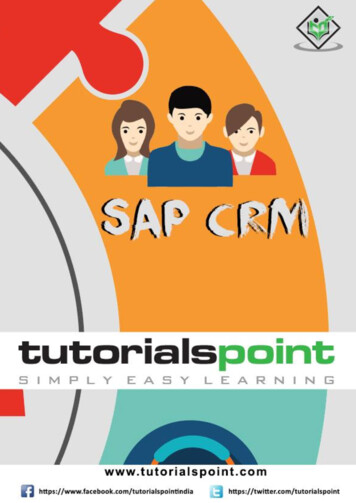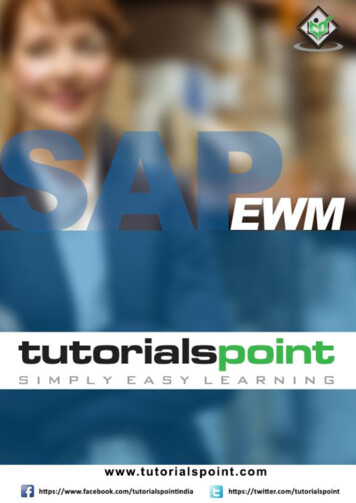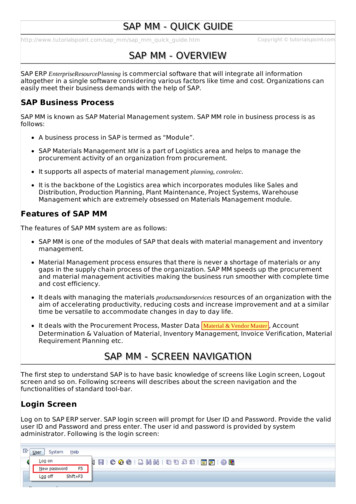
Transcription
SAP MM - QUICK GUIDEhttp://www.tutorialspoint.com/sap mm/sap mm quick guide.htmCopyright tutorialspoint.comSAP MM - OVERVIEWSAP ERP EnterpriseResourcePlanning is commercial software that will integrate all informationaltogether in a single software considering various factors like time and cost. Organizations caneasily meet their business demands with the help of SAP.SAP Business ProcessSAP MM is known as SAP Material Management system. SAP MM role in business process is asfollows:A business process in SAP is termed as “Module”.SAP Materials Management MM is a part of Logistics area and helps to manage theprocurement activity of an organization from procurement.It supports all aspects of material management planning, controletc.It is the backbone of the Logistics area which incorporates modules like Sales andDistribution, Production Planning, Plant Maintenance, Project Systems, WarehouseManagement which are extremely obsessed on Materials Management module.Features of SAP MMThe features of SAP MM system are as follows:SAP MM is one of the modules of SAP that deals with material management and inventorymanagement.Material Management process ensures that there is never a shortage of materials or anygaps in the supply chain process of the organization. SAP MM speeds up the procurementand material management activities making the business run smoother with complete timeand cost efficiency.It deals with managing the materials productsandorservices resources of an organization with theaim of accelerating productivity, reducing costs and increase improvement and at a similartime be versatile to accommodate changes in day to day life.It deals with the Procurement Process, Master Data Material & Vendor Master , AccountDetermination & Valuation of Material, Inventory Management, Invoice Verification, MaterialRequirement Planning etc.SAP MM - SCREEN NAVIGATIONThe first step to understand SAP is to have basic knowledge of screens like Login screen, Logoutscreen and so on. Following screens will describes about the screen navigation and thefunctionalities of standard tool-bar.Login ScreenLog on to SAP ERP server. SAP login screen will prompt for User ID and Password. Provide the validuser ID and Password and press enter. The user id and password is provided by systemadministrator. Following is the login screen:
Standard Tool-bar IconSAP screens tool-bar are shown in the following image:SAP screen tool-bars are briefly described as:Menu Bar - Menu bar is the top line of dialog window in the SAP system.Standard Toolbar - Standard functions like save, top of page, end of page, page up, pagedown, print, etc. are available in toolbar.
Title Bar - Title Bar displays the name of the application/business process you are currentlyin.Application Toolbar - Application specific menu options are available on this toolbar.Command Field - To start a business application without navigating through the menutransaction, some logical codes are assigned to the business processes. Transaction codesare entered in the command field to directly start the application.Standard Exit KeysExit keys are used to exit the module or to log off. They are used to go back to the last accessedscreen. Following are the standard exit keys used in SAP:New Session IconFor creating a new session we use the following keys shown in the below image:
Log OffIt is a good practice to log off from the SAP system when you finish your work. There are severalways of login off from the system but it can be done using following instructions as shown inimage:SAP MM - PROCUREMENT PROCESSEvery organization acquires material or services to complete its business needs. The process ofbuying materials and obtaining services from vendors or dealers is procurement. Procurementprocess should be done in such a way that it is ordered in correct quantity, with a proper value atthe proper time. It is subdivided into following parts:Basic ProcurementSpecial ProcurementBasic ProcurementIt is a process of acquiring goods or services in the right amount, at the right price at the right time.So the method of getting services, supplies, and equipment from a vendor seller, at the right priceat the right time in right amount is termed as Procurement. The quality of procurement isattempting to “get the right balance”, consider the following example:Organizations try and keep inventory levels at a minimum due to the prices associated withhigh levels of inventory; however at identical time it is very expensive to prevent productiondue to shortages in raw materials.Getting the minimum price for a product or service is often necessary, however the balancebetween product availability, quality, and vendor seller relations is also necessary.Procurement LifecycleMost modern organizations procurement follow some sequential steps which are described below:Requirement and Information Gathering
Procurement process starts with gathering information about product and its quantity. Then forrequired products and services, it is necessary to look for suppliers who can satisfy therequirements.Supplier ContactAfter gathering requirements one will look for the suppliers who can fulfill the requirements. Basedon that quotation request or information request can be made to suppliers or direct contact can bemade with them.Background ReviewOnce the supplier is known product/service quality is checked, and any necessities for servicessuch as installation, warranty and its maintenance are investigated. Some samples of the productscan be obtained for quality examination.NegotiationSome negotiations with suppliers is made regarding price, availability and delivery schedule of theproducts/services. After this a contract is signed that is a binding legal document between supplierand ordering party. A contract will include all necessary information like price and quantity ofmaterial, delivery date, etc.Order fulfillmentOrdered material will be shipped, delivered to the ordering party and supplier is paid accordingly.Training and Installation of product or services may also be included.Consumption, Maintenance and DisposalAs the products/service is consumed the performance of the products or services is evaluated andany follow up service support if required is analyzed.Contract RenewalOnce the product or services are consumed or contract expires and needs to be renewed, or theproduct or service is to be re-ordered, company experience with vendors and service provider isreviewed. If the products or services are to be re-ordered, the company decides whether to orderfrom previous supplier or think about new suppliers.Basic Procurement ActivitiesBasic Procurement activities flow is given in the following image:
A brief introduction of Procurement activities is given n ofrequirementIt is the logical subdivision where it is determined that what material orservices are required to company, and which supplier can fulfill therequirement.Creating PurchaseRequisitionIt is the phase in which purchasing department is informed about therequirement of items or services required for business purpose. Arequisition is a internal document.Creating PurchaseOrderIt is the phase when order is created from requisition and it is approvedand assigned to a supplier.Goods receipt/Invoice ReceivedIt is the phase in which the material is received by the company and thecondition and quality are verified. In this phase Invoice is received fromthe vendor seller.Invoice verification/Vendor PaymentIt is the phase in which the vendor seller is paid from the company andreconciliation of the invoice and PO is accomplished.Type of Basic ProcurementThere are 2 types of Basic procurement which are shown below:Procurement for Stock vs ConsumptionExternal vs Internal ProcurementProcurement for Stock vs ConsumptionThe following points show the difference of Procurement for Stock vs. Consumption:Procurement for Stock - A stock material is a material that is kept in stock. Thesematerials are kept in stock once received from the vendor. The stock of this material keepson increasing or decreasing based on amount of the quantity received or issued. To order amaterial for stock, the material must have a master record within the system.Procurement for Direct Consumption - When procurement is for direct consumption i.e.it will be consumed as soon as it is received, the user should specify the consumptionpurpose. To order a material for consumption, the material may have a master record withinthe system.External vs Internal Procurement
The following points show the difference of External vs Internal Procurement:External procurement - It is the process of procuring goods or services from externalvendors. There are 3 basic forms of external procurement generally supported by thePurchasing component of IT system.One time orders are generally used for material and services that are ordered irregularly.Longer-term contracts with the subsequent issue of release orders - For materialsthat are being ordered regularly and in large quantities, we can negotiate deal with thevendor seller for pricing or conditions & record then in a contract. In a contract you alsospecify the validity date.Longer-term scheduling agreements and delivery schedules - If a material is orderedon an everyday basis and is to be delivered according to an exact time schedule, then youset up a scheduling agreement.Internal Procurement - Large corporate organizations may own multiple separatebusinesses or companies. Internal Procurement is process of getting material and servicesfrom among identical company. So, each of these companies maintains a completebookkeeping system with separate Balance, Profit & Loss Statements so that when tradeoccurs between them it will be recorded.Special ProcurementSpecial stocks are stocks that are managed differently as these stocks did not belong to companyand these are being kept at some particular location. Special procurement and special stockstypes are divided into the subsequent areas.Consignment StocksMaterial that is available at our store premises, however it still belongs to the vendor seller/Owner ofthe material. If you utilize the material from consignment stocks, then you have to pay to thevendor.Third-party processingIn third-party processing, a company passes on a sales order to associate external vendor sellerwho sends the goods directly to the customer. The sales order is not processed by your company,however by the vendor seller. Third-party items can be entered in purchase requisitions, purchaseorders and sales orders.Pipeline handlingIn pipeline handling, the company needs not to order or store the material involved. It isobtainable as and when required via a pipeline forexample, oilorwater, or another style of cablesuchaselectricity. The material that is consumed is settled with the vendor seller on a regular basis.Returnable Transport StockThe company orders goods from a vendor seller. The goods are delivered with returnable transportpackaging pallets, containers that belongs to the vendor seller and is stored on the customer premisesuntil they return it to the company.SubcontractingThe vendor thesubcontractor receives components from the ordering party with the help of which itproduces a product. The product is ordered by your company through a purchase order. Thecomponents required by the vendor seller to manufacture the ordered product are listed in thepurchase order and provided to the subcontractor.Stock transfer using stock transport order
Goods are procured and supplied within a company. One plant order the goods internally fromanother plant receivingplant/issuingplant. The goods are procured with a special type of purchase order- the stock transport order. You'll be able to request and monitor the transfer of goods with a stocktransport order.SAP MM - ORGANIZATION STRUCTUREOrganization structure is the framework of company according to which business is conducted inevery company .Organization structure consists of many levels which have relationship to one oranother. Organization structure is also referred as enterprise structure. Enterprise structure ismade up of many organizational units having relationship with one another.SAP Implementation GuideWhen client purchases SAP it comes in a CD in form of software. When SAP is first installed, SAPhas its standard set up that needs to be configured according to the need of client i.e.organization.Configuration of SAP software like add fields, to change field names, to modify drop down lists etc.to adjust according to working of your organization is done through implementation guide knownas IMG. IMG is where we define enterprise structure and other settings that are required forfunctioning of SAP software according to need of an organization.SAP IMG PathTo do any type of configuration according to our organization need the first step is to reach theimplementation IMG guide screen. We can reach implementation guide in 2 ways:Menu pathTransactional codeMenu pathWe can navigate through the following path to reach out to IMG:SAP Easy Access Tools Customizing IMG Execute Project
Transactional codeBest and simple way to reach out any SAP screen is TCode i.e. transactional code. Transactionalcode to reach out IMG: SPRO SAPProjectReferenceObject. Enter the Transaction code in command fieldand then click on enter.SAP IMG
IMG screen can be reached out just by following the below steps:After SPRO, on the next screen click on SAP Reference IMG.Next Screen will appear as follows. This is the final screen from where we can do configurations.
Menu path for MM ConfigurationThe main menu paths for MM area are as follows:SAP Customizing Implementation Guide IMG Enterprise Structure DefinitionSAP Customizing Implementation Guide IMG Enterprise Structure AssignmentSAP Customizing Implementation Guide IMG Logistics General
A business process in SAP is termed as “Module”. SAP Materials Management MM is a part of Logistics area and helps to manage the procurement activity of an organization from procurement. It supports all aspects of material management planning,controletc. It is the backbone of the Logistics area which incorporates modules like Sales and Distribution, Production Planning, Plant Maintenance .


